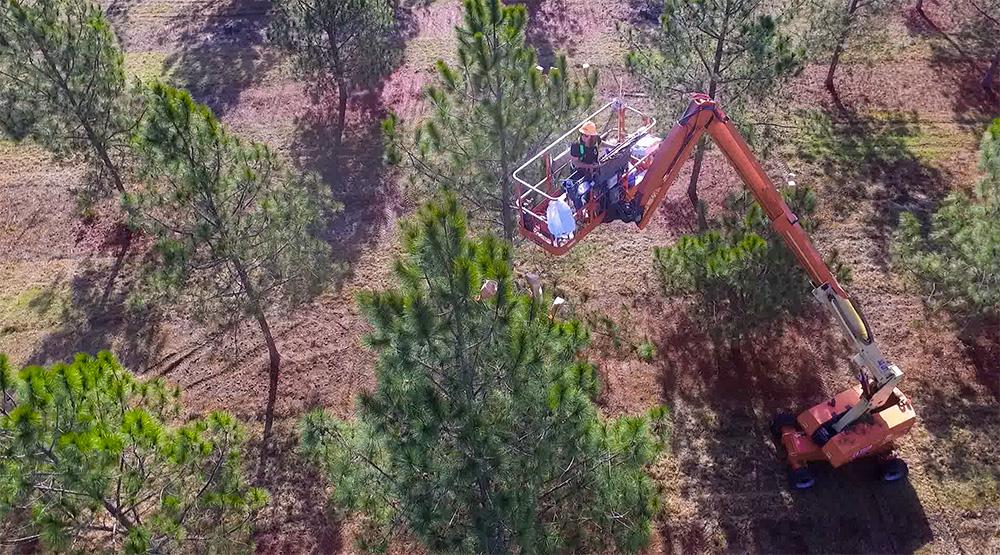How Foresters Use Controlled Pollination To Improve Tree Performance
Rayonier’s genetic research team offers a behind-the-scenes look at how we use a carefully-controlled pollination process to breed our best-performing tree families.
Down a long, dirt backroad in this tiny Georgia town, the beginnings of millions of acres’ worth of forests are budding in a Rayonier seed orchard.
The tiny pine cones forming in these carefully-bred trees—so tiny, they’re called “conelets”—will grow into the forests that provide wood products for future generations 20 years from now. Rayonier’s Forest Productivity & Sustainability team is determined to ensure they’ll be the best trees this company has ever seen.
Morning after morning, Genetic Resources Manager David Barker stops at this seed orchard on his way to the office, climbing into a mechanical lift to take a peek at the conelets. He is watching for signs that the conelets, which are the female “flower” part of the tree, are nearly ready to peel back their leafy outsides, called bracts. Known to researchers as “stage 5,” it will be the precious, short window of time when the conelets are receptive to pollination before the bracts close again.
Acting Fast in the Seed Orchard
When they’re nearly ready, Seed Production Manager Austin Smith snaps into action, working with a dedicated team of contractors to place a paper bag over each flower cluster. At this tender size, the conelet is very fragile and must be handled with care, so each bag is fitted with a wire that keeps the sides of the bag from injuring the flower. With the bags in place, the random pollen that comes with the wind, which could come from disease-prone or less robust trees, won’t be able to interfere with the conelets’ potential.
Austin and his helpers work from sunrise to sundown, using mechanical lifts to reach into the treetops and access the flowers. Tens of thousands of clusters are covered with bags that look similar to a paper lunch sack.
Introducing Pollen From Superior Trees
The research team will check the flowers again in the days to come until they’re open. Then they will use air guns to dust pollen from superior trees into each of the bags. (Rayonier also harvests the male part of the tree, called the catkin, to collect pollen in liter-sized jugs, drying it into a powdery substance and storing it in freezers for future years). The pollen comes from trees that Rayonier has chosen for disease resistance, straightness, volume growth, height and diameter.
“It’s really incredible to be able to actually make this happen when we’ve spent so much time on paper planning to make it happen,” Austin said during a rare break at Millwood recently. He likes to compare the process to horse breeding: the best of the best trees are selected, the result of years of genetic research.
Once the conelets’ scales close up, they are no longer receptive to pollen and the bags will be removed. The conelets will grow to full-size pine cones over the next 18 months. Then the cones will be harvested and sent to a seed extracting company. The resulting millions of seeds will then be shipped to our seedling nursery in Elberta, Alabama, for planting. After growing in the nursery for about a year, the baby pine trees will be planted in forests throughout our ownership across the United States.
Decades of Research
For over 50 years, our research team has nurtured seed orchards of pines that, unlike plantation pines, are intentionally spaced wide apart to allow their branches to spread, producing as many cones as possible. While the seeds that come from the Millwood Orchard will be sent into our forests, we also use the controlled pollination process on a much smaller scale for research as we continue to improve the parents of our future generations of trees.
Just a few weeks before the mass bagging operation in Millwood, Tree Improvement Forester Serenia O’Berry bagged and pollinated conelets in Rayonier’s Ohoopee Seed Orchard in Reidsville, GA, on a small cluster of trees. Each had to be specially tagged and marked to ensure researchers would know which male and female parents were used. Seeds from those cones will be harvested, planted and grown and monitored closely. In about five to six years, testing on the trees that grow from those seeds can determine whether they are ideal parents. It sounds like a long time to wait for results, but by forestry standards, it’s not. Researchers in previous generations had to wait as much as 15 years before testing their genetic breeding.
Serenia says selective breeding, something that has been done in the agricultural world for centuries, speeds up what nature would have done on its own over a much longer period of time. And, by managing the parents of our trees, Rayonier is able to make more uniform, consistently-growing stands of trees, which is ideal in forestry.
Despite the long hours during pollination season and countless trips up and down into the treetops to monitor the flowers, the research team looks forward to this process all year.
“I love getting to do the research, I love getting to be in a lift and I really love to be able to contribute to that next generation of trees,” Serenia says. “This is hands-down my favorite part of my job.”






